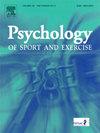Acute and chronic effects of guidelines-based progressive resistance exercise training compared to a low-intensity sham attention-control on signs and symptoms among young adult women with analogue generalized anxiety disorder: Design and methods of a randomized controlled trial
IF 3.3
2区 心理学
Q2 HOSPITALITY, LEISURE, SPORT & TOURISM
引用次数: 0
Abstract
Background
Recent evidence supports the positive effects of moderate-to-high-intensity, guidelines-based, progressive resistance exercise training (PRET) compared to waitlist controls among young adults with analogue Generalized Anxiety Disorder (AGAD). The true effects of PRET independent of potential social and psychological benefits of intervention engagement remain unclear. This 10-week randomized controlled trial (RCT) controls for such benefits by quantifying the acute and chronic effects of eight weeks of PRET compared to a low-intensity sham attention-control (SHAM) on GAD symptoms among young women (18-40y) with AGAD.
Methods
The full design and methods of this 10-week RCT are presented herein. Validated cut-scores on both the Psychiatric Diagnostic Screening Questionnaire GAD subscale (≥6) and the Penn State Worry Questionnaire (≥45) determined AGAD status. PRET was consistent with World Health Organisation and American College of Sports Medicine guidelines; participants performed two sets of 8–12 repetitions of eight exercises at 70–80 % one-repetition maximum (1RM). SHAM (20 % 1RM) was matched on all intervention features aside from load/intensity. AGAD status and worry severity (primary outcomes) were assessed at baseline, post-two-week familiarization, week 4, week 8, and one-month follow-up. Secondary outcomes were assessed weekly. Two acute resistance exercise trials were nested at weeks one and eight to quantify acute response and potential training-induced changes in acute response.
Conclusion
This 10-week RCT advances knowledge by anticipated replication of the effects of guidelines-based PRET among young women with AGAD, investigation of a minimally-beneficial dose threshold (i.e., low-intensity SHAM) and dose-response, and control of plausible social and psychological influences of intervention engagement.
基于指南的渐进式阻力运动训练与低强度假注意控制对患有类似广泛性焦虑症的年轻成年女性体征和症状的急性和慢性影响:一项随机对照试验的设计和方法
背景:最近的证据支持中高强度、基于指南的渐进式抗阻运动训练(PRET)对患有类似广泛性焦虑症(AGAD)的年轻人的积极作用。PRET独立于干预参与的潜在社会和心理效益之外的真正效果尚不清楚。这项为期10周的随机对照试验(RCT)通过量化8周PRET与低强度假注意控制(sham)对患有AGAD的年轻女性(18-40岁)GAD症状的急性和慢性影响来对照这些益处。方法:本文介绍了这项为期10周的随机对照试验的完整设计和方法。精神病学诊断筛查问卷GAD子量表(≥6)和宾夕法尼亚州立大学焦虑问卷(≥45)的有效分值确定了AGAD状态。PRET符合世界卫生组织和美国运动医学学院的指导方针;参与者以70-80%的最大单次重复(1RM)进行两组8-12次重复的8个练习。除负荷/强度外,SHAM (20% 1RM)在所有干预特征上都匹配。在基线、两周熟悉后、第4周、第8周和1个月随访时评估AGAD状态和担忧严重程度(主要结局)。次要结果每周评估一次。在第1周和第8周进行了两项急性阻力运动试验,以量化急性反应和潜在训练引起的急性反应变化。结论:这项为期10周的随机对照试验通过预期复制基于指南的PRET在AGAD年轻女性中的作用,研究最小有益剂量阈值(即低强度SHAM)和剂量反应,以及干预参与的合理社会和心理影响的控制,推进了知识的发展。
本文章由计算机程序翻译,如有差异,请以英文原文为准。
求助全文
约1分钟内获得全文
求助全文
来源期刊
CiteScore
6.40
自引率
5.90%
发文量
172
审稿时长
69 days
期刊介绍:
Psychology of Sport and Exercise is an international forum for scholarly reports in the psychology of sport and exercise, broadly defined. The journal is open to the use of diverse methodological approaches. Manuscripts that will be considered for publication will present results from high quality empirical research, systematic reviews, meta-analyses, commentaries concerning already published PSE papers or topics of general interest for PSE readers, protocol papers for trials, and reports of professional practice (which will need to demonstrate academic rigour and go beyond mere description). The CONSORT guidelines consort-statement need to be followed for protocol papers for trials; authors should present a flow diagramme and attach with their cover letter the CONSORT checklist. For meta-analysis, the PRISMA prisma-statement guidelines should be followed; authors should present a flow diagramme and attach with their cover letter the PRISMA checklist. For systematic reviews it is recommended that the PRISMA guidelines are followed, although it is not compulsory. Authors interested in submitting replications of published studies need to contact the Editors-in-Chief before they start their replication. We are not interested in manuscripts that aim to test the psychometric properties of an existing scale from English to another language, unless new validation methods are used which address previously unanswered research questions.

 求助内容:
求助内容: 应助结果提醒方式:
应助结果提醒方式:


